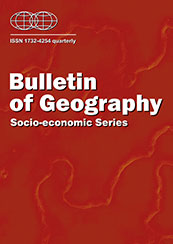Relations between theoretical and real-time accessibility for inter-regional, intra-regional and intra-urban car journeys: The example of Poland
Relations between theoretical and real-time accessibility for inter-regional, intra-regional and intra-urban car journeys: The example of Poland
Author(s): Szymon WiśniewskiSubject(s): Geography, Regional studies, Economic development, Transport / Logistics
Published by: Wydawnictwo Naukowe Uniwersytetu Mikołaja Kopernika
Keywords: accessibility; travel time; car transport; Poland;
Summary/Abstract: The article presents the results of research devoted to comparing accessibility in terms of theoretical and real travel times by car at inter-regional, intra-regional and intra-urban scales. The research strives to achieve three types of aim. The methodological aim is to assess the suitability of the data for research into transport geography, in particular with regard to accessibility. This objective also focuses on developing a method for acquiring and processing source data from suppliers. The cognitive goal is to analyse the spatial differentiation of theoretical and real travel times at different spatial scales. In terms of application, the focus is on the use of real travel time data for transport planning. Data on theoretical travel times includes the author’s own calculations based on analyses whose key assumption is that cars move on a road network at the maximum speeds allowed by the law with all other variables being excluded. The other source of data (on real travel times) is the Distance Matrix Response provided by Google Maps APIs. Due to methods such as isochrones and cumulative accessibility it was concluded that data obtained from Google servers is highly useful for research into transport geography, including time accessibility analyses. The patterns presented here however cannot be treated uncritically or used for unrestricted analysis. With regard to the cognitive goal, it should be emphasized that spatial variations in travel differences, resulting from theoretical and real variants for journeys between regional cities in Poland, between settlement units within one region, or within one of its large cities, are heterogeneous depending on the nature and length of the journey. Therefore, depending on the spatial extent of analysis, divergences in travel times should be expected.
Journal: Bulletin of Geography. Socio-economic Series
- Issue Year: 2018
- Issue No: 41
- Page Range: 45-58
- Page Count: 14
- Language: English

